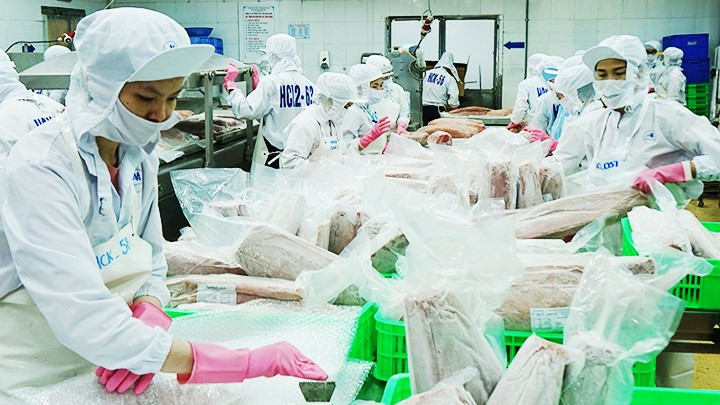In the first two months of the year, Vietnam's total export turnover reached 64.27 billion USD, an 8.4% increase compared to the same period last year, according to the General Statistics Office under the Ministry of Finance. Twelve commodities recorded an export turnover of over 1 billion USD, accounting for 77.7% of total export turnover, with four of them exceeding 5 billion USD, making up 54.6%.
Promising outlook
In February, for the first time in history, Vietnam's coffee exports reached nearly 1.1 billion USD in a single month. In total, the first two months of the year saw an export volume of 284,000 tonnes, equivalent to 1.58 billion USD. Despite a 28.4% decline in volume, the export value increased impressively by 26.2% compared to the same period in 2024. This achievement not only reaffirms Vietnam’s position in the global coffee market but also opens the potential to surpass the 6-billion-USD mark this year.
In the seafood sector, Le Hang, Communications Director of the Vietnam Association of Seafood Exporters and Producers (VASEP), stated that seafood exports recorded remarkable growth in the first two months of the year, reaching 1.423 billion USD, up 18.2% over the same period in 2024. Shrimp remained a highlight, contributing 542.387 million USD, with a growth rate of 30.8%. "The export outlook for shrimp in 2025 is quite optimistic if there are no major market disruptions. Import prices in key markets have been rising since October 2024, and shrimp prices are expected to remain high throughout the year thanks to stable inventory levels, boosting confidence among both exporters and importers".
According to Truong Van Cam, Vice Chairman and General Secretary of the Vietnam Textile and Apparel Association (VITAS), the textile and garment industry met its 2024 export target of 44 billion USD, achieving a growth rate of 11.26% compared to 2023. This momentum has continued in the first two months of 2025, with export turnover reaching 5.634 billion USD, a 9.3% increase year-on-year. This success was attributed to efforts in market diversification, technological innovation, and effectively capitalising on shifting global orders amidst rising demand for textiles and garments. With these early advantages, Vietnamese textile enterprises are confident in achieving the 2025 export target of 48 billion USD.
"Many businesses have already secured orders through the second quarter of 2025. Additionally, US tariff policies have yet to impact Vietnam's textile industry significantly. As of now, the US remains the largest export market for the sector", Cam added.
 |
| Many businesses have already secured orders through the second quarter of 2025. (Photo: ANH NGUYEN) |
Efforts to diversify markets
Under Government’s Resolution No.25, to achieve a national GDP growth target of 8% or higher, exports must increase by more than 12%. Additionally, the trade surplus must reach 30 billion USD. This presents a significant challenge amid global trade fluctuations and evolving US trade policies, which have increasingly become unfavourable for exporting countries, including Vietnam.
Specifically, the US is considering the expansion of tariff coverage on pharmaceuticals, automobiles, semiconductors, sawn wood, and forest products at 25%. Moreover, the Office of the United States Trade Representative (USTR) has been reviewing and compiling a country-by-country assessment of non-market or unfair trade practices that create barriers to exports. Based on these findings, the US will adjust its trade policies toward countries with large trade deficits to mitigate disadvantages for American businesses and the economy.
From the business perspective, Ngo Sy Hoai, Vice Chairman of the Vietnam Timber and Forest Products Association, expressed concerns over the potential 25% tariff expansion on sawn wood and forest products. As a result, some US customers have become hesitant to sign import contracts with Vietnamese suppliers. "Wood enterprises are striving to diversify their export markets by expanding into Australia, the Middle East, and New Zealand to avoid ‘putting all their eggs in one basket’. However, the increased export volume to these markets remains modest and is unlikely to fully compensate for the potential losses in the US market".
The Vietnam Timber and Forest Products Association has submitted an official request to the Ministry of Industry and Trade, the Ministry of Finance, and other relevant agencies, urging them to promptly consider reducing import tariffs on wood products from the US. Currently, Vietnam imposes a 20-25% tariff on American furniture, which should be quickly lowered to 0% to avoid a retaliatory 25% tariff. This measure would help the wood industry maintain stability in export activities and protect this crucial market. Each year, Vietnam exports approximately 9 billion USD worth of wood and wood products to the US.
At the Government’s regular press conference in February, Deputy Minister of Industry and Trade Nguyen Sinh Nhat Tan emphasised that Vietnam, as an open economy, remains committed to trade liberalisation in its integration process. The tariff gap for US goods is minimal and may continue to decrease in the future, as Vietnam aims to reduce tariffs on multiple products. Some US products with strong competitive advantages, such as automobiles, agricultural goods, liquefied natural gas, and ethanol, will benefit from this policy. At the same time, it will create positive import flows from the US, contributing to improving the trade balance between the two countries.
















